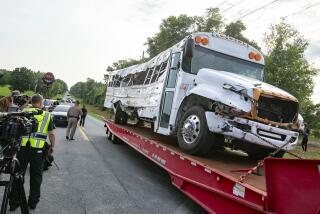Farm Census to Seek Statistics on Accidents : Agriculture: The hope is that reliable information will lead to ways to reduce the profession’s many deaths and injuries.
- Share via
WASHINGTON — Farmers have long known that they were risking life and limb to climb on a tractor or combine. But how much of a risk is it? The government intends to find out.
For the first time, the government’s five-year census of agriculture is asking every farmer and rancher in the nation to disclose any accidents that occurred in their operations.
The responses could lead to ideas for preventing the injuries that have made farming one of the most dangerous occupations in the country, say government officials and health experts.
“There is no good method of tracking injuries on the farm. You just don’t know what is happening out there,” said Laura Marvel, a research nurse at the New York Center for Agricultural Medicine and Health in Cooperstown. “This is going to be an interesting question.”
An estimated 300 children and 2,500 adults die on the farm every year. Experts think that tens of thousands more are seriously injured or exposed to harmful chemicals and biological hazards that may cause lung disease, cancer, reproductive disorders and skin problems.
The five-year agricultural census is considered the most thorough source of data about American farmers--who they are, where they live, what they grow and how much they earn.
Two million four-page questionnaires are being mailed out this month, with the responses due in February.
Congress and the Administration use the answers to plan for subsidy and loan programs, crop research and rural development.
“Last time we found a lot more part-time farmers, because they can’t afford to pay the bills” from farm income alone, said Ana Distefano, a spokeswoman for the Census Bureau. “You’re going to find a lot more people doing that again.”
Farm cooperatives and trade associations decide where to put new plants and services based on the census. Agribusinesses use the numbers to decide what new products farmers want and where to market them.
Looking at the 1987 survey, John Deere saw that farmers were keeping their old tractors instead of buying new ones, Distefano said. Deere officials “realized they had to stock up on new parts and had to train people to work on old tractors,” she said.
The injury data will tell health experts how many farmers and farm workers were hurt or killed this year and where they live.
The questionnaire asks farmers to report any injuries that were fatal, resulted in lost working time or required medical care in 1992.
Some recent farm injuries have attracted national attention, because of doctors’ heroic efforts to reattach limbs severed by farm machinery. John Thompson, an 18-year-old North Dakotan, lost both his arms to power machinery.
But there are many other hazards. Recent studies have shown that farmers are more likely to die of leukemia, non-Hodgkin’s lymphoma and multiple myeloma than any other occupational group. Other research has found higher mortality rates for lip, prostate and stomach cancer.
More to Read
Sign up for Essential California
The most important California stories and recommendations in your inbox every morning.
You may occasionally receive promotional content from the Los Angeles Times.













